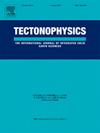加的斯湾阿尔加维陆架东部上新世-第四纪变形构造
IF 2.6
3区 地球科学
Q2 GEOCHEMISTRY & GEOPHYSICS
引用次数: 0
摘要
在靠近欧亚板块边界的区域挤压背景下,沿着瓜迪亚纳河和法鲁市之间的东部阿尔加维大陆架北部海湾加的斯大陆边缘,评价了上新世至第四纪的构造变形证据。我们研究了一组广泛的二维高分辨率地震反射剖面,这些剖面是在先前发表的地震地层模型中构建的。通过地震地层解释和区域对比,我们确定了研究区中更新世(0.9 ~ 026 Ma)沿陆架的主要角不整合,以及影响研究区上新世-第四纪沉积单元广泛沉积断裂的变形构造。一些变形特征表明新构造活动:ENE-WSW至NE-SW逆冲运动前中更新世陆架沉积,N-S至NW-SE褶皱,NNE-SSW至NNW-SSE高角度正断层影响中上更新世陆架沉积。这些构造是根据阿尔加维大陆架发生的两个主要变形阶段来解释的。前中更新世的第一期逆冲运动与伊比利亚西南边缘自托尔顿期以来的压迫统治相一致,这也记录在南部伊比利亚边缘的深水contoutic记录中,挤压事件导致地中海流出水的增强。中更新世至上更新世构造阶段的特征是沉积盖层的变形较小,涉及单个构造(即褶皱和断层),其中一些至少在末次盛冰期仍然活跃。这种较近的构造变形与葡萄牙大陆的缓慢隆升趋势和同代底辟再活动相一致,后者局部变形了伊比利亚西南边缘的晚第四纪沉积物。该研究提供了区域新构造活动产生上新世到更新世变形的额外证据,并对葡萄牙南部海岸沿海人口中心附近的近海环境具有最终的地震危险性评估意义。本文章由计算机程序翻译,如有差异,请以英文原文为准。
Pliocene-Quaternary deformational structures in the eastern Algarve continental shelf, Gulf of Cadiz
Evidences of tectonic deformation from the Pliocene to the Quaternary are evaluated on the northern Gulf Cadiz continental margin along the eastern Algarve continental shelf between the Guadiana River and Faro city, in a regional compressive context close to the Eurasia-Africa plate boundary. We studied an extensive set of 2D high-resolution seismic reflection profiles framed within previously published seismic-stratigraphic models. The seismic stratigraphic interpretation and regional correlation allow us to identify a major Middle Pleistocene (0.9–026 Ma) angular unconformity along the shelf, plus deformational structures affecting widespread depositional hiatuses in the Pliocene-Quaternary sedimentary units of the study area. Several deformation features indicate neotectonic activity: ENE-WSW to NE-SW thrusts moving pre-Middle Pleistocene shelf deposits and N-S to NW-SE folds and NNE-SSW to NNW-SSE high-angle normal faults affecting Middle to Upper Pleistocene shelf deposits. These structures are interpreted under the light of two major deformation phases that took place in the Algarve continental shelf. A first phase of Pre-Middle Pleistocene thrusting agrees with a dominant transpressive regime along the southwestern Iberian margin since the Tortonian, which is also recorded in the deep-water contouritic record of the southern Iberian margin, where compressional events caused intensification of the Mediterranean Outflow Water. A Middle to Upper Pleistocene tectonic phase is characterized by less intense deformation of the sedimentary cover involving individual structures (i.e., folds and faults), some of which remained active at least up to the Last Glacial Maximum. This more recent tectonic deformation is compatible with slowly uplifting trend recognized in the Portuguese mainland, and coetaneous diapiric reactivation that locally deformed Late Quaternary sediments along the southwestern Iberian margin. The study lends additional evidence of regional neotectonic activity producing Pliocene to Pleistocene deformation, and having ultimate implications for seismic hazard assessment, in offshore settings close to coastal population centers along the southern Portuguese coast.
求助全文
通过发布文献求助,成功后即可免费获取论文全文。
去求助
来源期刊

Tectonophysics
地学-地球化学与地球物理
CiteScore
4.90
自引率
6.90%
发文量
300
审稿时长
6 months
期刊介绍:
The prime focus of Tectonophysics will be high-impact original research and reviews in the fields of kinematics, structure, composition, and dynamics of the solid arth at all scales. Tectonophysics particularly encourages submission of papers based on the integration of a multitude of geophysical, geological, geochemical, geodynamic, and geotectonic methods
 求助内容:
求助内容: 应助结果提醒方式:
应助结果提醒方式:


